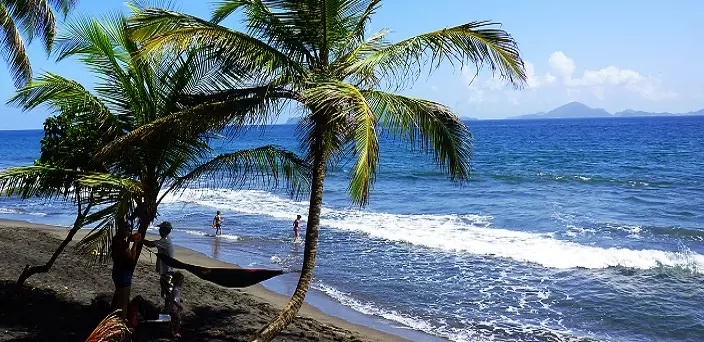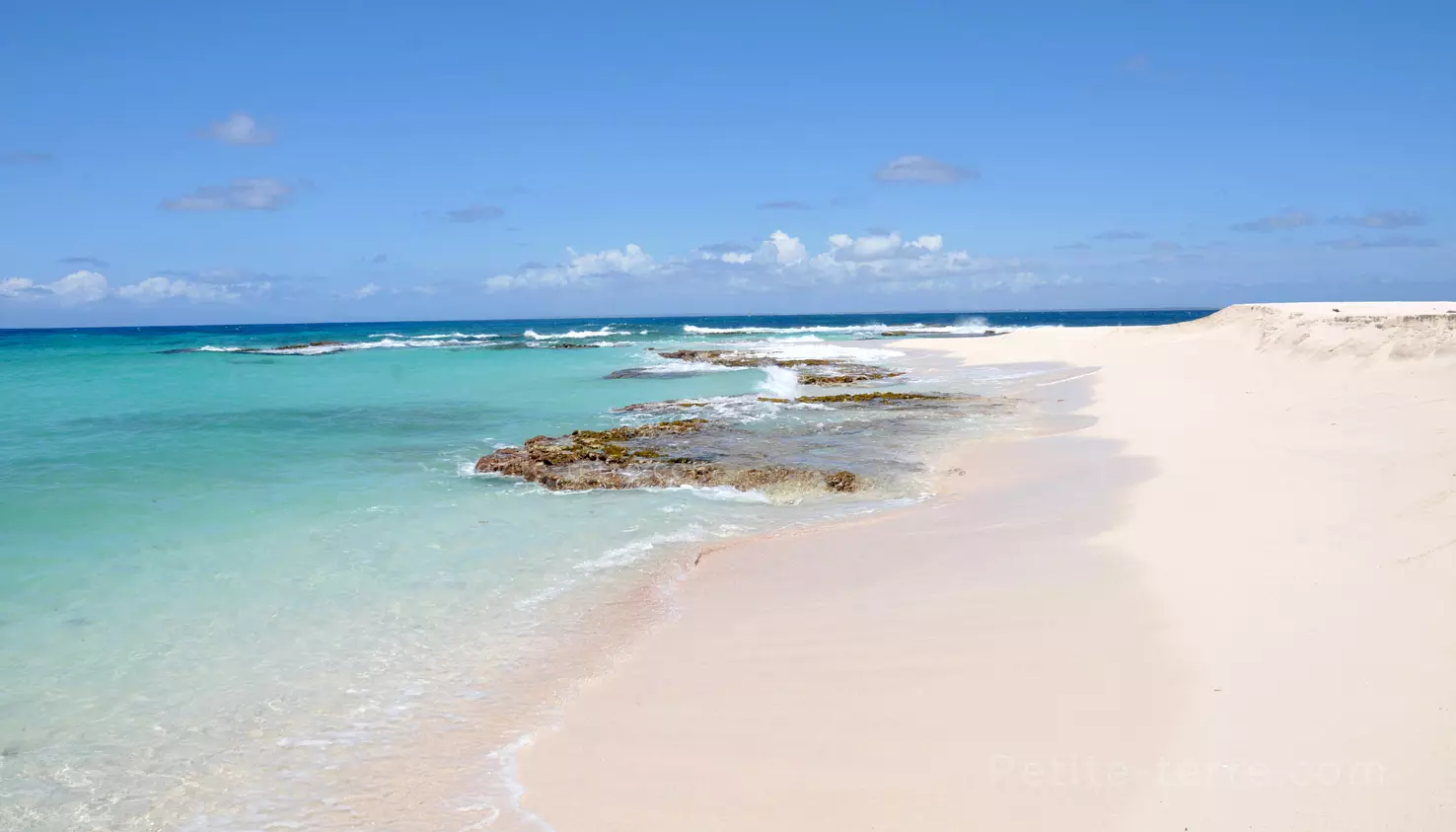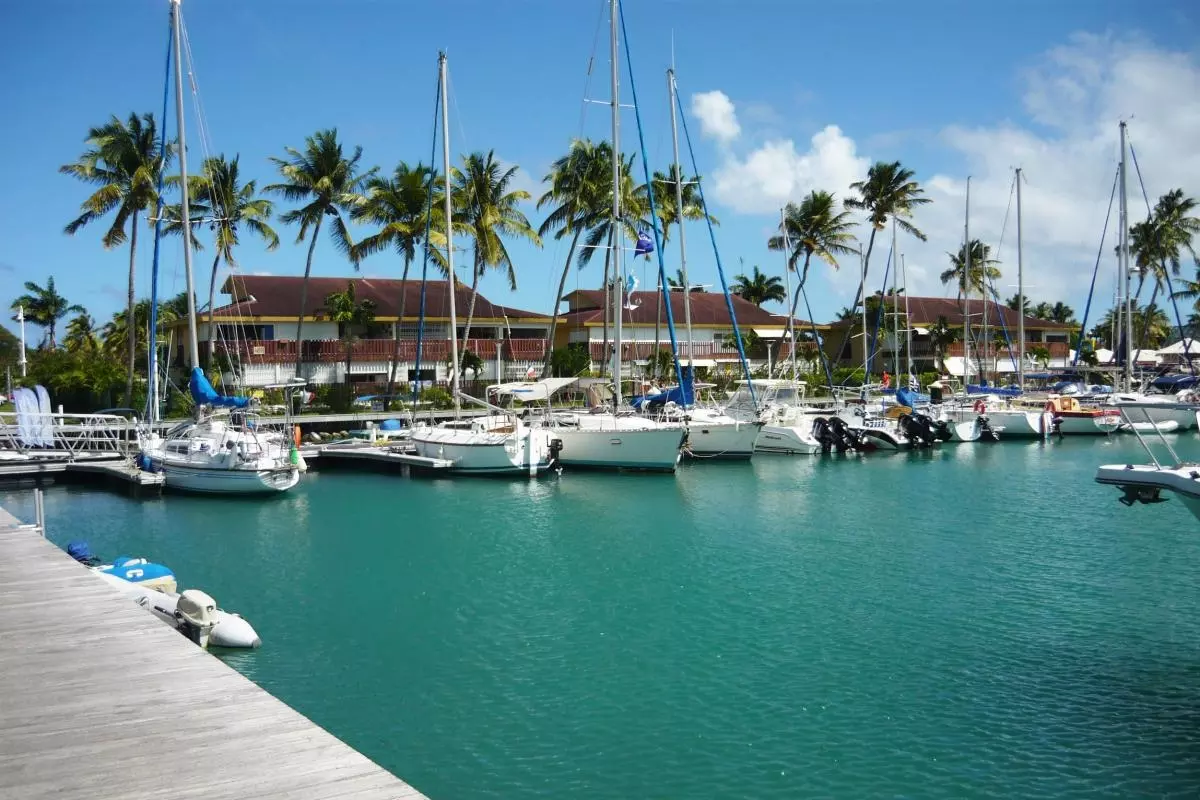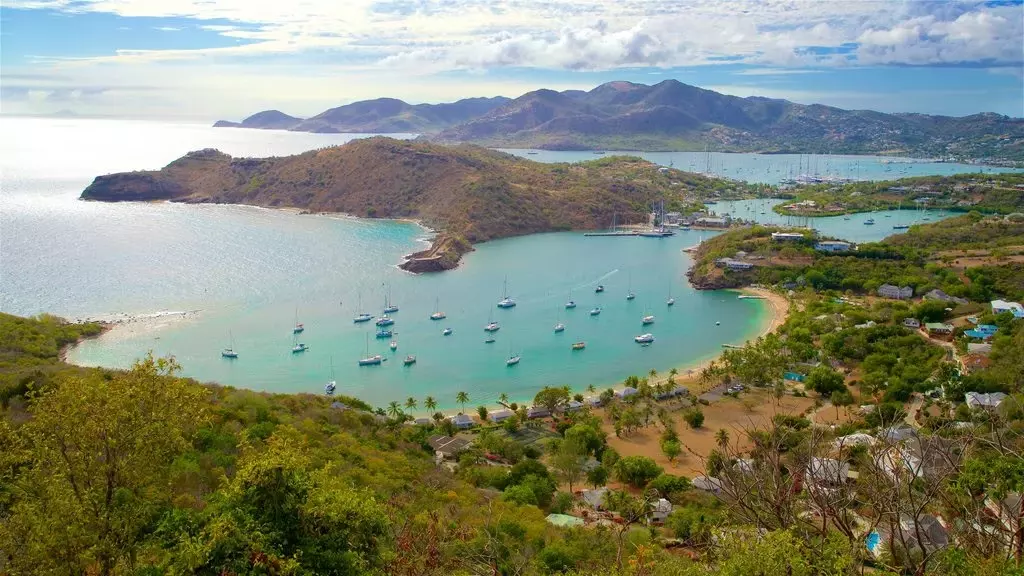Antigua to Guadalupa

1 • Jolly Harbour
Depart to Jolly Harbour, a relaxing Caribbean town with open-air waterfront bars, perfect for enjoying a cocktail at sunset. Greencastle Hill Park is one of the highest points in Antigua and is renowned for its views and megaliths.
1 • Jolly Harbour

Depart to Jolly Harbour, a relaxing Caribbean town with open-air waterfront bars, perfect for enjoying a cocktail at sunset. Greencastle Hill Park is one of the highest points in Antigua and is renowned for its views and megaliths.

2 • Montserrat
ontserrat, also known as the "Emerald Isle of the Caribbean," is part of the Lesser Antilles archipelago. The island is characterized by the presence of the active volcano Soufrière Hills, located in the southern part, beautiful and colorful coral reefs, and caves along the coast.
The island's vegetation includes magnificent and rare specimens, rainforests, and fruit plantations covering the area of the Central Hills. The fauna also consists of endemic animals.
The island's beaches are mostly dark and are mostly located on the west coast. The only white sand beach is Rendezvous Bay, located in the north of the island. Some of the best beaches include Little Bay, Bunkum Bay, Woodlands Beach (the best spot for surfers), and Old Road Bay.
The island has lost much of its cultural heritage from the colonial era due to the volcanic eruption in 1997, which destroyed much of the territory. Plymouth, the capital and one of the most precious cities in the Caribbean, is no longer standing. However, numerous other trails offer interesting views to admire this beautiful island. For example, walking along some paths like the Oriol Walkaway, an excellent spot for birdwatching, allows you to appreciate the beauty of nature.
Take a trip to discover the ghauts, deep gorges that carry rainwater from the mountains to the sea, which are also very interesting.
Montserrat also boasts a lively nightlife, with many characteristic venues where locals gather to socialize, relax with friends, have a drink, and enjoy themselves.
2 • Montserrat

ontserrat, also known as the "Emerald Isle of the Caribbean," is part of the Lesser Antilles archipelago. The island is characterized by the presence of the active volcano Soufrière Hills, located in the southern part, beautiful and colorful coral reefs, and caves along the coast.
The island's vegetation includes magnificent and rare specimens, rainforests, and fruit plantations covering the area of the Central Hills. The fauna also consists of endemic animals.
The island's beaches are mostly dark and are mostly located on the west coast. The only white sand beach is Rendezvous Bay, located in the north of the island. Some of the best beaches include Little Bay, Bunkum Bay, Woodlands Beach (the best spot for surfers), and Old Road Bay.
The island has lost much of its cultural heritage from the colonial era due to the volcanic eruption in 1997, which destroyed much of the territory. Plymouth, the capital and one of the most precious cities in the Caribbean, is no longer standing. However, numerous other trails offer interesting views to admire this beautiful island. For example, walking along some paths like the Oriol Walkaway, an excellent spot for birdwatching, allows you to appreciate the beauty of nature.
Take a trip to discover the ghauts, deep gorges that carry rainwater from the mountains to the sea, which are also very interesting.
Montserrat also boasts a lively nightlife, with many characteristic venues where locals gather to socialize, relax with friends, have a drink, and enjoy themselves.

3 • Deshaies
Deshaies is a small, preserved, and timeless fishing village. Let yourself be seduced by its magnificent beaches and all the water activities associated with them, but also by this small village perfectly representative of Creole culture. Deshaies is ideally located for whale watching in the Caribbean Sea.
3 • Deshaies

Deshaies is a small, preserved, and timeless fishing village. Let yourself be seduced by its magnificent beaches and all the water activities associated with them, but also by this small village perfectly representative of Creole culture. Deshaies is ideally located for whale watching in the Caribbean Sea.

4 • Basse-Terre
The island of Basse-Terre takes its name from the language of the 17th-century navy and corresponds to the leeward coast (thus protected from the winds), and not to its relief, which is rather high in this part of the island. This is because it is the area where the Soufrière volcano reaches its highest point in the center.
With an average water and sea temperature of 27°C, there will be no problem with climatic adaptation both in and out of the water.
4 • Basse-Terre

The island of Basse-Terre takes its name from the language of the 17th-century navy and corresponds to the leeward coast (thus protected from the winds), and not to its relief, which is rather high in this part of the island. This is because it is the area where the Soufrière volcano reaches its highest point in the center.
With an average water and sea temperature of 27°C, there will be no problem with climatic adaptation both in and out of the water.

5 • Les Saintes
Now you can head to Les Saintes, a picturesque archipelago composed of nine islets where enchanting bays, lush vegetation, tropical climate, and ancient traditions merge. For anchoring, you will be spoilt for choice: the most popular spot is undoubtedly in front of the Pain de Sucre beach on Terre-de-Haut Island.
In this area, you can admire a stretch of white sand surrounded by coconut palms and crystal-clear waters teeming with colorful fish. From here, you will set off to explore the island nicknamed "Rio in miniature" and famous for its colorful houses, breathtaking views, culinary specialties based on local fruit, and Fort Napoleon with its museum.
Alternatively, you can access Pompierre Beach overlooking a lagoon of calm, shallow waters with wonderful turquoise colors.
5 • Les Saintes

Now you can head to Les Saintes, a picturesque archipelago composed of nine islets where enchanting bays, lush vegetation, tropical climate, and ancient traditions merge. For anchoring, you will be spoilt for choice: the most popular spot is undoubtedly in front of the Pain de Sucre beach on Terre-de-Haut Island.
In this area, you can admire a stretch of white sand surrounded by coconut palms and crystal-clear waters teeming with colorful fish. From here, you will set off to explore the island nicknamed "Rio in miniature" and famous for its colorful houses, breathtaking views, culinary specialties based on local fruit, and Fort Napoleon with its museum.
Alternatively, you can access Pompierre Beach overlooking a lagoon of calm, shallow waters with wonderful turquoise colors.

6 • Marie-Galante
Head to Marie-Galante, also known as the "Island of a Hundred Windmills" due to the presence of over a hundred windmills scattered across the territory, like sentinels of the numerous sugar mills and rum distilleries.
The atmosphere of the island is anchored in its rural past, with large sugar cane plantations, farmers wearing wide-brimmed hats, and the traditional kabwé, ox-drawn carts along the gentle hills surrounded by forests where time seems to stand still.
The North coast is characterized by high cliffs and beautiful almost deserted beaches, some of which are considered the most beautiful in the entire Guadeloupe archipelago. One of these is Anse Canot, a crescent-shaped beach just north of the town of Saint-Louis, accessible only by boat. On one side, the beach is enclosed by an imposing rocky wall plunging into the sea, while on the other side the typical vegetation of the place expands and offers shady and cool corners when the sun starts to get too hot.
In the southeastern part of the island lies the beach of Feuillère, which offers peace and relaxation under its palms. You can overlook a lagoon of transparent water protected by a coral reef, a destination for divers and snorkeling enthusiasts.
For dinner, you can book at La Playa, one of the most popular restaurants on the island to taste seafood, and then enjoy the nightlife where Creole music and dance create a truly contagious mix. Once on the island, do not hesitate to discover the local cuisine and taste the island's famous sweets: Caca bœuf or Tourment d'amour.
6 • Marie-Galante

Head to Marie-Galante, also known as the "Island of a Hundred Windmills" due to the presence of over a hundred windmills scattered across the territory, like sentinels of the numerous sugar mills and rum distilleries.
The atmosphere of the island is anchored in its rural past, with large sugar cane plantations, farmers wearing wide-brimmed hats, and the traditional kabwé, ox-drawn carts along the gentle hills surrounded by forests where time seems to stand still.
The North coast is characterized by high cliffs and beautiful almost deserted beaches, some of which are considered the most beautiful in the entire Guadeloupe archipelago. One of these is Anse Canot, a crescent-shaped beach just north of the town of Saint-Louis, accessible only by boat. On one side, the beach is enclosed by an imposing rocky wall plunging into the sea, while on the other side the typical vegetation of the place expands and offers shady and cool corners when the sun starts to get too hot.
In the southeastern part of the island lies the beach of Feuillère, which offers peace and relaxation under its palms. You can overlook a lagoon of transparent water protected by a coral reef, a destination for divers and snorkeling enthusiasts.
For dinner, you can book at La Playa, one of the most popular restaurants on the island to taste seafood, and then enjoy the nightlife where Creole music and dance create a truly contagious mix. Once on the island, do not hesitate to discover the local cuisine and taste the island's famous sweets: Caca bœuf or Tourment d'amour.

7 • Petit-Terre
Consisting of two islands, Terre-de-Haut and Terre-de-Bas, this uninhabited archipelago is located about ten kilometers southeast of the Castles point. Protected by both a maritime and a terrestrial natural reserve, the islands of Petite-Terre, surrounded by a coral reef, host an incredible natural richness.
From a faunal point of view, we can find Antillean iguanas, hermit crabs, lizards, sedentary and migratory birds, sea turtles, and a wide variety of fish species. As for the flora, guaiachi, agaves, violets, and paulownias predominate in the environment. A true paradise! To learn more about this protected heritage, head to the lighthouse of Terre-de-Bas, nicknamed "The Lighthouse at the End of the World," which hosts a museum dedicated to flora and fauna.
7 • Petit-Terre

Consisting of two islands, Terre-de-Haut and Terre-de-Bas, this uninhabited archipelago is located about ten kilometers southeast of the Castles point. Protected by both a maritime and a terrestrial natural reserve, the islands of Petite-Terre, surrounded by a coral reef, host an incredible natural richness.
From a faunal point of view, we can find Antillean iguanas, hermit crabs, lizards, sedentary and migratory birds, sea turtles, and a wide variety of fish species. As for the flora, guaiachi, agaves, violets, and paulownias predominate in the environment. A true paradise! To learn more about this protected heritage, head to the lighthouse of Terre-de-Bas, nicknamed "The Lighthouse at the End of the World," which hosts a museum dedicated to flora and fauna.

8 • St. François
St. François is a charming village located on the southern coast of Grande-Terre Island. The local tourist marina offers welcoming docks, nautical services, shops, and small restaurants, as well as traditional tuculs with palm-thatched roofs where you can enjoy punch and lobster in sauce chien, an exquisite sauce made with scallions.
Walking along the streets of this Caribbean village, you will discover beautiful wooden houses, a picturesque fishing harbor, a casino, and a museum of local history housed in a 19th-century prison. A lively and rich market full of fruits, exotic vegetables, and spices is also a must-see.
After visiting the village, you can relax on Raisins Clairs Beach. This is one of the most famous beaches in Guadeloupe, with fine sand and a magnificent turquoise lagoon ideal for endless baths. The coccoloba trees, whose fruits resemble grapes, and the walls with wooden sheds along the beach guarantee pleasant breaks for a tasty picnic. For those who want a bit of activity, St. François boasts the only 18-hole golf course in Guadeloupe, designed by Robert Trent Jones.
8 • St. François

St. François is a charming village located on the southern coast of Grande-Terre Island. The local tourist marina offers welcoming docks, nautical services, shops, and small restaurants, as well as traditional tuculs with palm-thatched roofs where you can enjoy punch and lobster in sauce chien, an exquisite sauce made with scallions.
Walking along the streets of this Caribbean village, you will discover beautiful wooden houses, a picturesque fishing harbor, a casino, and a museum of local history housed in a 19th-century prison. A lively and rich market full of fruits, exotic vegetables, and spices is also a must-see.
After visiting the village, you can relax on Raisins Clairs Beach. This is one of the most famous beaches in Guadeloupe, with fine sand and a magnificent turquoise lagoon ideal for endless baths. The coccoloba trees, whose fruits resemble grapes, and the walls with wooden sheds along the beach guarantee pleasant breaks for a tasty picnic. For those who want a bit of activity, St. François boasts the only 18-hole golf course in Guadeloupe, designed by Robert Trent Jones.

9 • English Harbour
Head south to English Harbour, known for Nelson's Dockyard, an important former British military base where Horatio Nelson lived in the late 1700s.
It is the last functioning Georgian-era naval dockyard in the world and has recently undergone a major restoration and redevelopment.
From the hills overlooking Shirley Heights naval yard, an ancient military outpost located about 149 meters above sea level, you can enjoy a fantastic view of the area. Visit this location on Sunday afternoons or evenings to listen to local music groups playing steel drums while enjoying delicious local grills as you watch the sunset.
9 • English Harbour

Head south to English Harbour, known for Nelson's Dockyard, an important former British military base where Horatio Nelson lived in the late 1700s.
It is the last functioning Georgian-era naval dockyard in the world and has recently undergone a major restoration and redevelopment.
From the hills overlooking Shirley Heights naval yard, an ancient military outpost located about 149 meters above sea level, you can enjoy a fantastic view of the area. Visit this location on Sunday afternoons or evenings to listen to local music groups playing steel drums while enjoying delicious local grills as you watch the sunset.
